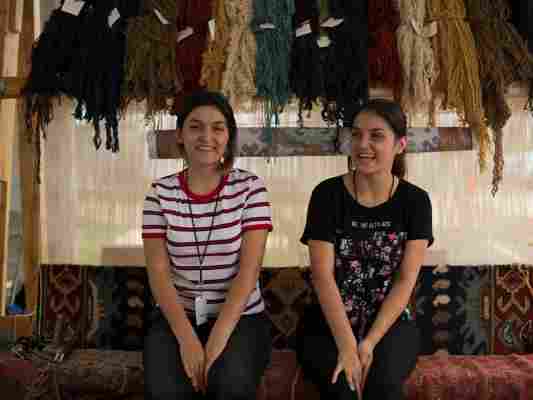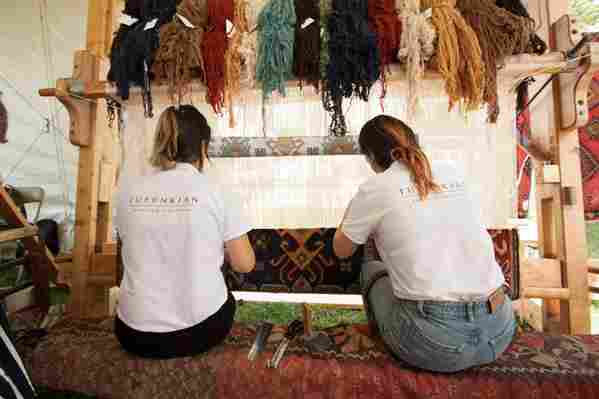
Twin sisters Sahkanush and Haykanush Stepanyan learned rugmaking while still teenagers at a craft center in Gyumri, Armenia’s second-largest city. Today at 23, they work for Tufenkian, a company that specializes in carpets made of hand-carded, -spun, -dyed, and -knotted wool. Under a hot July sun on the National Mall in Washington, D.C., they are stretching warp threads vertically over the timbers of a large loom, entwining the horizontal weft thread between them, over and under in a basket-like pattern.
Perhaps the most renowned of the Armenian arts is carpet making, a domestic craft that women took up at home in the late hours of the day as a quiet reprieve from cooking, cleaning and childcare. For the Stepanyan sisters, who are participants at the Smithsonian Folklife Festival this summer, once each row is completed, individual strands of thread will be knotted around pairs of warp threads, varying the colors to make intricate patterns.
At her loom, the weaver makes the patterns her own, placing motifs in endless combinations, organizing them into grand tableaux, then most importantly, breaking the dominant symmetries with unique variations of form and color, making the patterns flow and breathe. Over countless hours, the vision she holds in her mind emerges, in row upon row of brilliant thread. She is the architect of a vast garden, choosing and planting each tiny strand.
“These rugs were mainly used for personal reasons, such as dowry pieces, gifts, commemorative pieces,” explains Hratch Kozibeyokian , who is a master weaver and scholar on the history of the craft, and serves as president of the Armenian Rugs Society , located in Glendale, California. Eventually the work was commercialized, he says, during the 19th century and merchants began paying women by the square inch.
But today, Kozibeyokian says that Armenian rugmaking is healthier than it has been in a long time: “There is this huge revival.” Across the country, traveling teachers are introducing the art to young women who didn’t learn it at home. Where the strands of tradition were broken, they are now being retied.
The Armenian communities, he says, are now rediscovering their histories through the stories that these rugs tell. Kozibeyokian says he relies on a knowledge that has been handed down through the years one generation to another, and cultivated through experience and ongoing study. “I come from a family that has been in this trade, in this craft for at least the four generations that I know of.” And untold generations before that, he says. “[A rug] is still produced the same way as it was a thousand years ago.” Although occasionally the weaver will be a man, today just as in ages past, it is usually women who take responsibility for maintaining and extending the art, training the weavers who will carry it forward.
Despite a long and rich history of carpet making, Armenians have had to battle to maintain a hold over their own tradition. The work of the Armenian weavers was so prized that it was praised by observers from Herodotus (“brilliant colors”) to Marco Polo (“the choicest and most beautiful”). During the Middle Ages, Armenians rugs were traded and dispersed throughout the Middle East and Europe so that by the time of the Renaissance, Armenian rugs appeared under the feet of saints in altarpieces by painters as renowned as Hans Memling, Hans Holbein and Lorenzo Lotto. But unfortunately, as these woven masterpieces were swept up into a global trade and appreciation, their provenance was lost and many Armenian rugs and their styles have been either appropriated by, or attributed to, other cultures.
Take for example, the oldest carpet known is the Pazyryk , which dates from the 5th century B.C.E. Although found in Siberia and now housed in the Hermitage Museum in St. Petersburg. It is now claimed to be both Persian and Armenian. Levon Abrahamian , one of the Folklife Festival curators, takes pains to note the “rather complicated and delicate situation” when scholarly and political interests overlap. Referring to contested areas in the south and east of Armenia, he notes that “Karabagh and Syunik regional carpets are claimed by Azerbaijanis to be Azerbaijani as a result of territorial claims.”
The geometric motifs found on Armenian rugs date back millennia. Long before the pinwheel symbol was corrupted by the Nazis to become the swastika , many ancient cultures saw it as a symbol of life, luck and well-being. In Armenian hands, it flowered into a form with anywhere from two arms to more than 12, eventually becoming the wheel of eternity, a symbol of eternal life. In carpets, the symbol takes on many guises—stars, medallions, jagged S-shapes. During the Christian era—Armenia officially adopted the religion at the beginning of the fourth century C.E.—crosses and angels began to appear.
But even today, it is the pre-Christian iconography that predominates: strong, jagged geometries and sometimes flora and fauna—drawn in deep rich colors that make liberal use of a red made from the Armenian cochineal, a scale insect native to the Armenian highlands. Scholars continue to pursue research that links the iconography of Armenian rugs to both pagan and Christian symbols, including those literally carved in stone, either as architectural elements or on khachkars, memorial “cross stones” that combine both cross and wheel.
It takes time and care to perfect the famed Armenian (or Ghiordez) double knot that makes the colorful patterned pile of a carpet, but it’s worth the effort. The knot makes for a sturdier, more durable weave. (Today, the Armenian knot is now also widely known in the business as a Turkish knot.)

One of the most prized items in the White House collection is an 11- by 18-foot rug, crafted by Armenian girls living at an orphanage in Ghazir, Lebanon. It took the girls, 10 months to complete, tracing out a veritable Garden of Eden in more than 4 million individually tied knots. Birds perch amid twining greenery. Proud beasts circle one another. Holding in the great profusion of nature is complex geometry, unfolding like the symmetries of a kaleidoscope.
After Armenia was invaded by the Red Army in 1920 and swallowed by the Soviet Union, rugmaking was brought into factories and became forbidden in the home. Soviet-era carpets often featured portraits of Lenin and Stalin; and at times, the image of Mount Ararat, the symbol of the Armenian Soviet Socialist Republic. Still, the tradition was handed down and continued to survive behind closed doors. “Those women who inherited this skill, some of them still have it and they still weave it,” Kozibeyokian says. “Although it was illegal during the Soviet era, it was done in homes in a secret way, like many other things.”
The 1980s saw a resurgence of interest in Armenian carpets in the United States, largely due to the efforts of the Armenian Rugs Society, which was founded in Washington, D.C., at the start of the decade. In 1984, a milestone exhibition of rugs that bore inscriptions of Armenian text as part of their designs opened at the Kimbell Art Museum in Fort Worth, Texas. Made possible by the database of rugs maintained by the Society, it was the first major exhibition to focus on Near Eastern rugs that carried inscriptions. The texts often contained a Bible verse, or honored an esteemed guest, or simply noted where and when the rug was made. The Gohar Carpet , whose Armenian date translates to 1700, is poignantly inscribed: “I, Gohar, full of sin and weak of soul, with my newly learned hands wove this rug. Whosoever reads this say a word of mercy to God for me.
Since the collapse of the Soviet Union, traditional Armenian rugmaking is once again thriving. Kozibeyokian notes that the Armenian Rugs Society has teamed with another nonprofit to teach the art to more than 400 students in nine different villages. And that is but one initiative. Other organizations are pursuing their own.
At the Folklife Festival, Dianna Hovhannisyan is weaving rugs of silk. The finer thread makes for a doubly dense weave, says Kozibeyokian, with as many as 144 knots per square inch. It is exacting work. “Also, what makes it difficult is the silk shines and reflects the light on the weaver’s eyes,” he explains. “The weaver cannot sit and weave as long as they do on the other non-silk rugs. They have to take a break and rest.”
The work of this new generation is a testament to the resilience of Armenian people and Armenian culture. In many ways, this enduring tradition of rugmaking recalls the age-old hand-tied double knot. Attempts to unravel it by brute force are bound to fail. “The harder you pull on the pile,” Kozibeyokian explains, “the tighter the knot gets.”
The Folklife Festival will conclude after a final run from July 4 through July 8, 2018.
